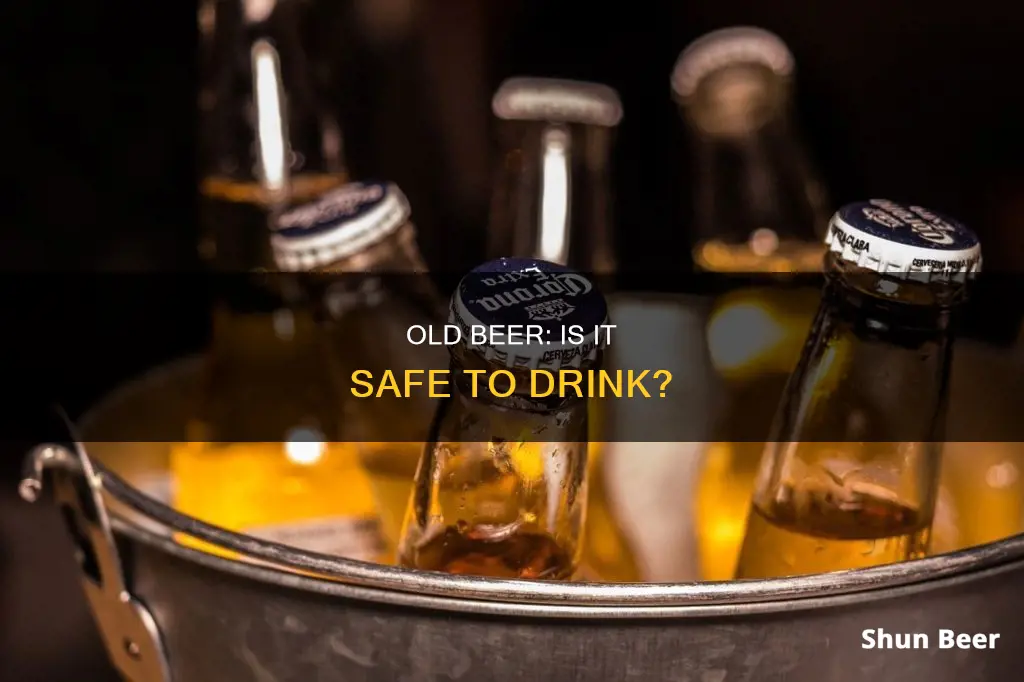
It is generally agreed that drinking beer that is 5 years old will not harm you, but it might not taste very nice. It is likely to have developed a cardboard or paper-like flavour, and the hop aromas will have faded. However, some people actively seek out older beers, believing that they develop new and interesting flavours. It is also thought that the higher the alcohol content, the better a beer will taste after 5 years.
What You'll Learn

Is it safe to drink?
It is generally safe to drink beer that is five years old. However, it is important to examine the conditions in which the beer was stored. If the beer has been exposed to sunlight or extreme temperatures, it may not be safe to consume. Additionally, if the seal of the bottle or can has been broken, bacteria may have contaminated the beer, making it unsafe for consumption.
When it comes to the taste of five-year-old beer, it is likely that the flavour will have deteriorated. This is especially true for light-bodied and low-ABV beers, as their flavours tend to break down faster than darker and high-ABV beers. The beer may have acquired off-flavours, such as cardboard or soap, due to oxidation. However, some people intentionally age their beers to develop new flavours that may be pleasant.
It is worth noting that the higher the alcohol content in the beer, the less concern there is about its use-by date. Beers with higher alcohol content tend to age better and have a lower risk of contamination.
Overall, while it may be safe to drink five-year-old beer, the taste experience may not be as enjoyable, especially for lighter beers. It is recommended to consume beer within six months to a year of its manufacturing date for optimal taste.
Beer Transfer Mechanics: How Does It Work?
You may want to see also

Will it taste good?
Whether or not a 5-year-old beer will taste good depends on a variety of factors. Firstly, the style of beer matters; light body, low ABV beers tend to have their flavour deteriorate faster than darker, high ABV beers. So, a 10% ABV Imperial Stout will handle years of ageing better than a 4% American Lager, which will likely see flavour changes within the first year.
Secondly, the packaging of the beer is important. Canned beer will generally do much better over extended periods than bottled beer. This is because cans don't let any light in, preventing the beer from becoming "skunky", as well as maintaining an airtight seal better. Beer bottles, on the other hand, can be dark brown, green, or clear. The darker the colour, the better it is at preventing UV light from reaching the beer and spoiling its flavour. However, even dark bottles still let some UV light reach the beer. In addition, the caps on beer bottles have a seal that can break down over time, allowing air into the bottle.
Thirdly, the temperature at which the beer is stored is a key factor. It is best to keep beer under 50 degrees Fahrenheit when possible, so storing it in a refrigerator is ideal. Allowing beer to get warm or overheated, such as by leaving it out in the sun, is not a good idea. It is also important to keep the beer at a consistent temperature; frequent temperature fluctuations are not good for beer.
Finally, the freshness of the beer at the time of purchase matters. If you buy beer that is not fresh, it is already starting to lose its intended flavour. Retail stores should strive to maintain consistent storage temperatures and prevent beer from being stored where UV light can reach it.
In conclusion, a 5-year-old beer may still be drinkable and may even have developed some new and interesting flavours. However, there is also a good chance that the flavour will not be appealing, and it may taste unpleasant or stale. Ultimately, it is up to the individual to decide whether or not they want to take the risk and try the old beer.
Beer Foam Stones: Do They Work?
You may want to see also

How should beer be stored?
Beer is best stored in a cool, dark place, with the ideal temperature depending on the type of beer. For strong beers such as Barley Wines, Tripels, and Imperial Stouts, the ideal temperature is around 12-16°C. For standard ales like Pale Ales, IPAs, and Stouts, 10-12°C is best, while for lighter beers such as Lagers, Pilsners, and Wheat beers, the ideal temperature is 7-10°C.
It's best to store beer in brown bottles or cans since they block out light that can cause "skunked beer". Skunked beer occurs when light-sensitive hops in beer are exposed to too much light, resulting in a sulphur off-flavour. Green bottles offer some protection but are not as effective as brown ones, and clear bottles offer no protection at all.
Overexposure to oxygen can also negatively affect beer, so it's best to store bottles upright to minimise the surface area exposed to oxygen. Cans are better at preventing oxidation than bottles due to their tighter seal, but the larger surface area of the can when upright means that the beer may oxidise slightly faster.
Other factors to consider when storing beer include humidity and movement. Humidity levels above 70% can cause mould to develop, while very low humidity can cause corks in bottles to dry out and crack. Storing beer in a location where it won't be disturbed is recommended, as too much movement can cause chemical changes that affect its flavour.
In summary, here are some key dos and don'ts for storing beer:
Dos:
- Store beer in a cool, dark place, ideally at the temperature you intend to serve it.
- Use brown bottles or cans to avoid light exposure.
- Store bottles upright to minimise oxygen exposure.
- Maintain humidity levels between 50% and 70%.
- Keep beer containers standing up, rather than on their sides.
Don'ts:
- Expose beer to sunlight or excessive heat.
- Store beer on its side, as this can cause a "yeast ring" and increase the risk of oxidation.
- Disturb stored beer unnecessarily, as this can cause chemical changes that affect its flavour.
Bottoms Up: How Do Self-Refilling Beer Cups Work?
You may want to see also

What are the health risks of drinking old beer?
Drinking old beer will not make you sick, but it will not taste as good as fresh beer. Beer is a perishable product that stales when exposed to light, oxygen, and heat, which degrade the organic compounds that make beer smell and taste great. The fermentation process used in brewing beer, as well as its low pH level and alcohol content, make it an unfriendly environment for bacteria to grow.
However, the flavour of beer will degrade over time. This is because, as the beer ages, the aroma and flavour compounds found in hops oxidize and dissipate. This results in a flatter, sweeter taste. Additionally, certain aromatic compounds can increase with prolonged exposure to oxygen, resulting in sweet, sherry-like flavours. The speed of these reactions depends on the alcohol content of the beer and how it is stored. Refrigerating beer slows the process of aging, so it is recommended to store beer in a cool, dark place, away from temperature fluctuations.
Opened beer has a much shorter shelf life than unopened beer. In general, opened beer will only be good for a day or two before the oxidation destroys the good flavours. Unopened beer, on the other hand, can last for several years past the expiration date if stored properly in a cool, dark place. However, the taste will still degrade over time, and it is not recommended to drink beer that is more than a few years old.
While drinking old beer will not make you sick, it is important to note that the beer may have lost its carbonation and become flat. Additionally, if the seal has been broken, the beer may have been exposed to bacteria and developed a vinegary taste. In this case, it is best to discard the beer.
Beer Diet: Does It Work?
You may want to see also

What are the signs that beer has gone bad?
Beer doesn't typically have an expiration date, and it can be safely consumed past its "best before" date. However, the taste and quality may deteriorate over time. Beer that has gone bad will typically taste stale or flat and may have off-flavours or a change in colour.
- Changes in Appearance: Beer that has gone bad may exhibit changes in colour, such as darkening or developing a hazy appearance. This could indicate oxidation or the growth of bacteria.
- Stale or Flat Taste: Beer relies on carbonation for its refreshing, crisp taste. Over time, carbonation can be lost, resulting in a flat or stale-tasting beer.
- Off-Flavours: The development of off-flavours is a tell-tale sign of beer going bad. It may taste sour, acidic, or have a vinegary character. These flavours can be caused by bacterial contamination or excessive oxidation.
- Sedimentation: While some beers naturally have sediment at the bottom of the bottle or can, an excessive amount of sediment or floating particles could indicate that the beer has gone bad.
- Bulging Cans or Bottles: If the container is bulging or swollen, it is a clear sign of a build-up of carbon dioxide due to refermentation. Beer in such containers should not be consumed.
- Rancid Odour: Beer that has gone rancid may emit a skunky or off-putting odour. This could be caused by a variety of factors, including light exposure, temperature fluctuations, or bacterial growth.
Understanding Beer Staffs: A Guide to Their Functionality
You may want to see also
Frequently asked questions
Yes, it is safe to drink beer that is several years old. Beer doesn't typically "expire" and there are no known harmful pathogens that can survive in beer. However, the taste may be affected.
Over time, beer will oxidise, which can result in off-flavours such as cardboard, sherry, paper, or soap. Hop aromas will also be muted.
Beer should be stored in a cool, dark area, at a temperature between 45° F and 55° F. Canned beer will generally be better for storage than bottled, as it prevents light from entering and maintains an airtight seal.







